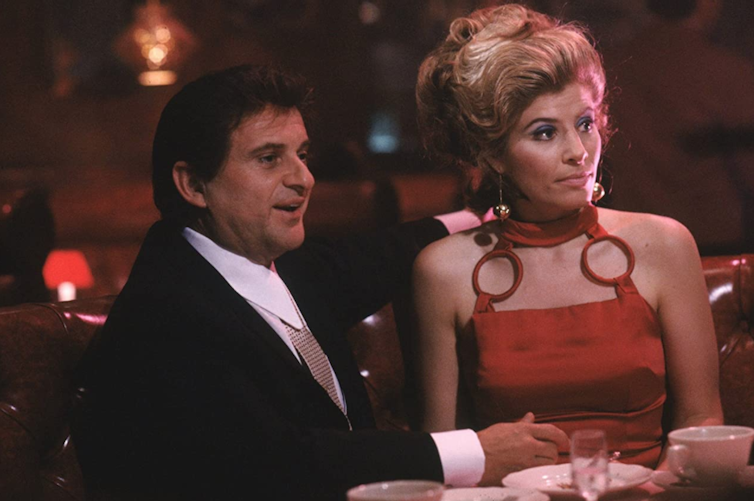GoodFellas at 30: Scorsese's massively influential, virtuoso gangster film
- Written by Adrian Danks, Associate professor in Cinema and Media Studies, RMIT University
It’s hard to imagine that Martin Scorsese’s GoodFellas is 30 years old. A massive influence on contemporary filmmakers ranging from Quentin Tarantino and Fernando Morales to David O. Russell and Paul Thomas Anderson, it remains one of the peaks of Hollywood genre filmmaking.
GoodFellas is a movie defined by an extraordinary, almost anthropological attention to experiential and procedural detail, a stylistic virtuosity that ranges across freeze-frames, majestic subjective tracking shots, overlapping and sometimes improvised dialogue, propulsive editing, dual voice-overs, a breathless pop-rock soundtrack, and an insider’s knowledge of the life of organised crime.
Documenting the 25-year story arc of a foot soldier on the fringes of the Mob, the film is both brilliantly designed and executed and a bravura mash-up of tones, styles and sensibilities, influenced by movies such as Truffaut’s Jules et Jim.
As an example, who can forget the wonderfully staged scene between Henry (Ray Liotta), Jimmy (Robert De Niro), Tommy (Joe Pesci) and his mother (played by Catherine Scorsese, the director’s own mother) as the boys drop in on their way to completing the murder of a “made man” they have bundled up into the boot of their car?
Despite the palpable tension — and this is not a movie for those suffering from any kind of anxiety disorder — this scene is remarkable for its equally humorous, affectionate, conversational and even sweet-natured tone, as well as the wonderful physicality of the performances.
Even when we hear Tommy mischievously ask his mother if he can borrow a large carving knife, the spell is never completely broken. As in GoodFellas’ greatest disciple, The Sopranos, we are hitching a ride with these characters until the very end, living each moment with them.
A highly ritualised world
This overwhelming feeling for the material realities and pleasures of the film’s chosen, often garish, milieu helps draw us into a largely masculine, chauvinist world defined by easy corruption, hair-trigger violence, moral ambivalence and imperiousness.
GoodFellas builds up a minutely rendered environment we both observe and are deceptively drawn into. As in many Scorsese films, we latch onto the story of an outsider inculcated into a highly ritualised, semiotic world. Unlike that found in many other period films, this world appears truly lived in with, as Scorsese suggests, every frame “packed with motion and detail”.
In the process, a sense of abundance is communicated that is often overwhelming. Although key collaborators such as editor Thelma Schoonmaker and cinematographer Michael Ballhaus have often and rightly been singled out for their contributions, the production design by Kristi Zea truly brings this “cloistered” and insular world to life.
 Joe Pesci and Katherine Wallach in Goodfellas. The just-right domestic interiors are richly suggestive.
Warner Bros
Joe Pesci and Katherine Wallach in Goodfellas. The just-right domestic interiors are richly suggestive.
Warner Bros
For example, the tacky, expensive but just-right domestic interiors are richly suggestive and immersive. From the moment the film opens mid-story — the harsh red taillights under-lighting Henry’s face as he proclaims, “As far back as I can remember, I always wanted to be a gangster” — we’re well and truly hooked.
Jump Into the Fire: music and performance
Scorsese’s movies are often difficult to pin down and describe. They regularly take their lead from a snatch of music, the riff from a particular song, or the rapid-fire transition from one track to another. This use of music feeds into their angular, sometimes abrupt, almost jazz-like rhythms and tones.
For example, the extraordinary, manic, cocaine-fuelled final day of Karen (Lorraine Bracco) and Michael’s freedom in the last stages of the film is scored by a head-spinning, needle-jumping combination of tracks by Harry Nilsson, Muddy Waters, The Rolling Stones, and many others.
Although the use of the compilation soundtrack has become a cliché, Scorsese’s choice of particular tracks and musical moments still seems remarkably fresh (Donovan’s Atlantis, anyone?).
The use of Derek and the Dominos’ keening, soaring “coda” from “Layla” to score the carefully arranged images of corpses discovered in the aftermath of Jimmy’s killing spree still takes your breath away.
It is also the close connection forged between music and performance that makes it difficult to imagine a particular moment, gesture or action scored by a different track.
Although one of the truly seminal gangster films, in its fusion of character, action and sound GoodFellas could almost qualify as a musical.
An uneasy love letter
GoodFellas sits somewhere near the mid-point of Scorsese’s career and was a significant return to peak form after his more disparate work of the 1980s. The movie ushers in a period of extraordinary productivity in the first half of the 1990s that takes in such key works as The Age of Innocence, his documentary A Personal Journey with Martin Scorsese Through American Movies, and GoodFellas’ “evil twin”, Casino.
In many ways, GoodFellas is an uneasy love letter to the gangster film replete with characteristic references to much-cherished earlier influences such as The Roaring Twenties.
 Goodfellas is an uneasy love letter to the gangster film.
Warner Bros
Goodfellas is an uneasy love letter to the gangster film.
Warner Bros
Following a conventional rise and fall narrative arc, and based on the nonfiction source Wise Guy by screenwriter Nicholas Pileggi, it is, perhaps, the defining work of Scorsese’s career. But it is also dangerously seductive.
Casino revisits many of the same tropes and features some of the same actors, but its abundance of information is exhausting, and the world of crime just isn’t much fun anymore.
When Pesci’s Tommy appears one final time to shoot straight at the camera in GoodFellas, scored by Sid Vicious’ version of My Way, you know where you’d rather be.
Authors: Adrian Danks, Associate professor in Cinema and Media Studies, RMIT University



